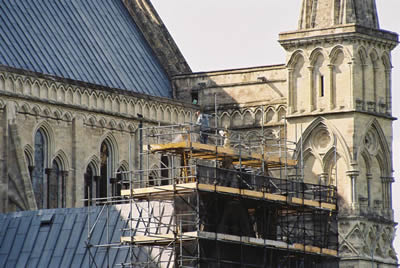The Major Repair Programme at Salisbury Cathedral
It was in 1986 that the then Clerk of Works at Salisbury Cathedral,
Peter Edds, Head of Buildings and Estate, explained, “Salisbury Cathedral took just 38 years to build in the 13th century. The MRP is expected to take 30 years to complete which gives some idea of the scope and extent of the work being undertaken. This work, with careful annual maintenance, should see the Cathedral’s fabric secure for at least the next 100 years. Along with our colleagues at

Chicksgrove Quarry supplies all the stone for the Major Repair Programme. To date work has been completed on the spire, tower, roof, West Front, North nave aisle, internal and external re-lighting, and the East, South and West cloisters. Current work is centred on the North Transept and North East Transepts. Work still to be undertaken includes the North East, East and the entire South sides of the Cathedral - including the Chapter House stonework - and the North side of the cloister.
“To give some idea of scale of the job, work on the roof involved general repairs plus stripping off approximately 4 acres of lead, melting it down, re-casting and finally re-laying it on the roof. In total that single task took 2½ years.”
The Cathedral is grateful to all its contractors whose work is invaluable. ADT Fire and Security are responsible for the fire alarm systems. A C Wallbridge, steeplejacks, check the lightening conductor at the top of the spire annually and replace the red warning lights there as needed! There are specialist stone carvers who produce individual carvings and statues. Norman & Underwood who carried out specialist works on the roof. Peter Marsh is a marvellous specialist photographer who takes ‘before’ and ‘after’ pictures of all the work carried out on the MRP. Horizon International provide and install the fall-arrest systems. Safety and Training Services provide all the Health & Safety training needed by Works Department staff on specific areas – for instance the scaffold, forklift truck driving and the fall-arrest system. Andy Pullen undertakes the Jos (high pressure) cleaning of stonework before the masons can start work. The scaffolding, a familiar sight to all who visit the Cathedral, belongs to the Cathedral but it relies on Deborah Services who are specialist scaffold erectors and strikers. Ann Ballantyne is the specialist paint conservator.
The cost of the MRP to date of circa £22 million has been funded by The Wolfson Foundation and English Heritage (31%), Cathedral reserves (21%), the Spire Appeal (37%) and the Friends of
Salisbury Cathedral’s specialist glazing team, headed by Sam Kelly, is one of only four cathedral teams in the country with the necessary skills to undertake work on medieval glass. Skilled labour of this kind is not generally available and the quality of work is one of excellence. In addition to the work they do on Salisbury Cathedral’s Major Repair Programme (MRP), the team undertake a significant amount of specialist glazing work for other churches and historic properties.
Sam Kelly writes:
Our department exists to keep the skills needed for the repair of the Cathedral but also enables us to offer our services to churches, architects, builders and private customers in the surrounding area who require specialist glazing work. This may include anything from plain lead light glazing to the conservation of Medieval stained glass.
 While our work on Salisbury Cathedral takes us from the high lantern windows of the tower to the protective glazing of the medieval glass of the West Front, the outside contract work we undertake has always formed an important and interesting part of our working life. There is a fascinating wealth of ancient and modern artistic and technical brilliance to be found in the stained glass of our churches. There is beautiful early glass, produced for the greater Glory of God, and for the education of the illiterate masses. There is the 19th century gothic revival period of Pugin, Wailes and Morris, and the later works of Whall, Clarke, Kempe and Comper. In more recent times we have seen outstanding works such as at Coventry Cathedral, the east window of Salisbury Cathedral and the fine west window at Sherborne Abbey.
While our work on Salisbury Cathedral takes us from the high lantern windows of the tower to the protective glazing of the medieval glass of the West Front, the outside contract work we undertake has always formed an important and interesting part of our working life. There is a fascinating wealth of ancient and modern artistic and technical brilliance to be found in the stained glass of our churches. There is beautiful early glass, produced for the greater Glory of God, and for the education of the illiterate masses. There is the 19th century gothic revival period of Pugin, Wailes and Morris, and the later works of Whall, Clarke, Kempe and Comper. In more recent times we have seen outstanding works such as at Coventry Cathedral, the east window of Salisbury Cathedral and the fine west window at Sherborne Abbey.
Stained glass as a craft has gone through many phases of artistic change and some introduction of new techniques, yet the basic craftsmanship of the trade has not changed and it would be no problem at all for a medieval glazier to work at our benches. The overriding concern when working on the conservation of any ancient or art object is to do no harm to the piece, and when working on more vulnerable pieces we must also consider providing a protected environment. This can take various forms and will require us providing a detailed condition report with conservation proposals.
One of the pleasures of our work is the great variety of people we meet. It is rewarding being able to advise and assist them with their glazing projects and in many cases enjoy their building with them while work is taking place.
Issued by and further information from:















